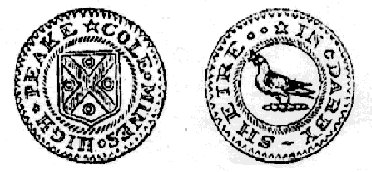
"High Peake Cole Mines in Darbyshire".

The token of Richard Shallcross.
In the seventeenth century a vast number of traders’ tokens were made and used. Almost every, different occupation (business) is represented in this series. A major impetus for the production of these tokens was the tremendous increase in trade with goods being made for cash sale, but this coincided with a severe shortage of small denomination coins. Consequently traders issued their own small value coinage to be given as change when selling goods. At that period timber, used extensively in building houses, ships, household heating and industrial use to smelt metals, became short in supply and the extraction and use of coal for these purposes increased enormously, particularly in the middle of seventeenth century. This increase in the coal industry, however, does not appear to have led to the issue of tokens by large numbers of colliery owners. Very, very few are known, of which three are quite well recorded: a half penny at Broughton Coal Pits in Cumberland, a half penny at Middleton Coal Pits in Yorkshire and a half penny at High Peak Coal Mines in Derbyshire.
Very little is known about Broughton Colliery in the seventeenth century although several other tokens exist for pits/collieries of that name in Cumberland. This token is unusual in that it is octagonal. It was issued by John Lamplugh in about 1670 and bears the legends;
Obv: JOHN LAMPLUGH
Rev: BROUGHTON COAL PITTS HIS HALF PENY.
Details of the Middleton mines in the same period are equally scarce. This token reads;
Obv: FRANCIS CONYERS OF MIDLTON. IN YORKSHIRE HIS HALF PENY 1669
Rev: FOR THE USE OF Ye COLE PITS.
In the latter part of the seventeenth century the Brandling family became involved with the Middleton collieries when Ralph Brandling of Felling, Co. Durham acquired the Middleton estate by marriage. Brandling is a well known name in the North East associated with coal mining.
The Derbyshire half penny bears the legends;
Obv: HIGH PEAKE COLE MINES
Rev: IN DARBYSHIRE.
The Coat of Arms of the ancient Shallcross family of Shallcross appear on the obverse of these tokens and the family crest features on the reverse - a martlet carrying a cross in its beak.
In 1611 six Shallcross family descents are recorded. The last male heir of the family died in 1733, whilst the youngest female heiress remained unmarried and died in 1776.
A John Shallcross was Sheriff of Derbyshire in 1638 and his son Richard, born in 1632 and called to the bar in 1660, was Surveyor of the North Duchy of Lancaster and Bailiff of the High Peak. Richard died in March 1676 and was buried at his birthplace, Taxall. There is little doubt that Richard owned the High Peak Collieries, and that he issued this token, dated by it style to between1664-1672. Richard's son John was the last male Shallcross heir and died in 1733. His heirs, the Jacsons later sold Shallcross Hall.
More of the history of the family and of the coal pits is contained in a document, indenture, dated 3rd May 1750, which now accompanies the token in my collection. However, the token and document were acquired totally separately at different times and from different sources.
The contents of this indenture may be summarised thus;
"On 19th May 1740, Richard Fitzherbert, Roger Jacson (sic) and Ann Shallcross granted (leased) their coals, and coal mines in the township of Bowden Midlecale in Derbyshire to William Carrington of Ashton Clough in Glossop, Derbys, yeoman and William Bennet of Chinley in Glossop, yeoman, for a period of 21 Years commencing on the 1st May 1742, at an annual rent of £30."
On the 3rd May, 1750 (date of document) Carrington and Bennet granted a one third part or share in these certain coals and coal mines to Robert Mottram, an excise officer from Salford, Lancs. This grant was for the remainder of the original 21 year lease and was for a yearly rent of £10 and a third part of taxes due, the profits and leases from the coals or coal mines being equally divided between the three parties (.i.e. Carrington, Bennet and Mottram).
Reproduced from an article in NMMA Newsletter No.15, Autumn 1999. © Graham Smith.